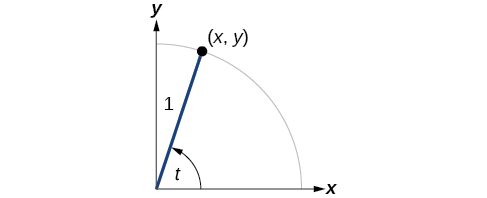
In this section you will:
and
A wheelchair ramp that meets the standards of the Americans with Disabilities Act must make an angle with the ground whose tangent is
or less, regardless of its length. A tangent represents a ratio, so this means that for every 1 inch of rise, the ramp must have 12 inches of run. Trigonometric functions allow us to specify the shapes and proportions of objects independent of exact dimensions. We have already defined the sine and cosine functions of an angle. Though sine and cosine are the trigonometric functions most often used, there are four others. Together they make up the set of six trigonometric functions. In this section, we will investigate the remaining functions.
We can also define the remaining functions in terms of the unit circle with a point
corresponding to an angle of
as shown in [link]. As with the sine and cosine, we can use the
coordinates to find the other functions.

The first function we will define is the tangent. The tangent of an angle is the ratio of the y-value to the x-value of the corresponding point on the unit circle. In [link], the tangent of angle
is equal to
Because the y-value is equal to the sine of
and the x-value is equal to the cosine of
the tangent of angle
can also be defined as
The tangent function is abbreviated as
The remaining three functions can all be expressed as reciprocals of functions we have already defined.
is equal to
The secant function is abbreviated as
is equal to
The cotangent function is abbreviated as
is equal to
The cosecant function is abbreviated as
If
is a real number and
is a point where the terminal side of an angle of
radians intercepts the unit circle, then
The point
is on the unit circle, as shown in [link]. Find
and
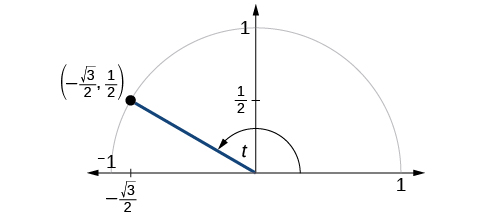
Because we know the
coordinates of the point on the unit circle indicated by angle
we can use those coordinates to find the six functions:
Find
and
when
We have previously used the properties of equilateral triangles to demonstrate that
and
We can use these values and the definitions of tangent, secant, cosecant, and cotangent as functions of sine and cosine to find the remaining function values.
Find
and
when
Because we know the sine and cosine values for the common first-quadrant angles, we can find the other function values for those angles as well by setting
equal to the cosine and
equal to the sine and then using the definitions of tangent, secant, cosecant, and cotangent. The results are shown in [link].
| Angle | |||||
|---|---|---|---|---|---|
| Cosine | 1 | 0 | |||
| Sine | 0 | 1 | |||
| Tangent | 0 | 1 | Undefined | ||
| Secant | 1 | 2 | Undefined | ||
| Cosecant | Undefined | 2 | 1 | ||
| Cotangent | Undefined | 1 | 0 |
We can evaluate trigonometric functions of angles outside the first quadrant using reference angles as we have already done with the sine and cosine functions. The procedure is the same: Find the reference angle formed by the terminal side of the given angle with the horizontal axis. The trigonometric function values for the original angle will be the same as those for the reference angle, except for the positive or negative sign, which is determined by x- and y-values in the original quadrant. [link] shows which functions are positive in which quadrant.
To help remember which of the six trigonometric functions are positive in each quadrant, we can use the mnemonic phrase “A Smart Trig Class.” Each of the four words in the phrase corresponds to one of the four quadrants, starting with quadrant I and rotating counterclockwise. In quadrant I, which is “A,” **a**ll of the six trigonometric functions are positive. In quadrant II, “Smart,” only **s**ine and its reciprocal function, cosecant, are positive. In quadrant III, “Trig,” only **t**angent and its reciprocal function, cotangent, are positive. Finally, in quadrant IV, “Class,” only **c**osine and its reciprocal function, secant, are positive.
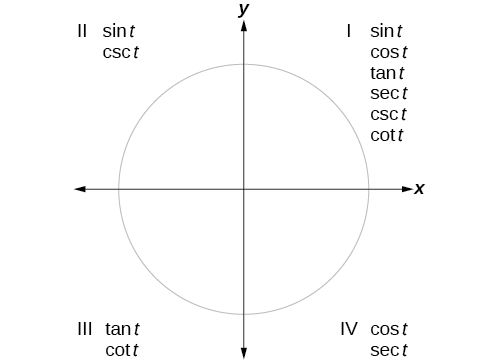
Given an angle not in the first quadrant, use reference angles to find all six trigonometric functions.
Use reference angles to find all six trigonometric functions of
The angle between this angle’s terminal side and the x-axis is
so that is the reference angle. Since
is in the third quadrant, where both
and
are negative, cosine, sine, secant, and cosecant will be negative, while tangent and cotangent will be positive.
Use reference angles to find all six trigonometric functions of
To be able to use our six trigonometric functions freely with both positive and negative angle inputs, we should examine how each function treats a negative input. As it turns out, there is an important difference among the functions in this regard.
Consider the function
shown in [link]. The graph of the function is symmetrical about the y-axis. All along the curve, any two points with opposite x-values have the same function value. This matches the result of calculation:
and so on. So
is an even function, a function such that two inputs that are opposites have the same output. That means
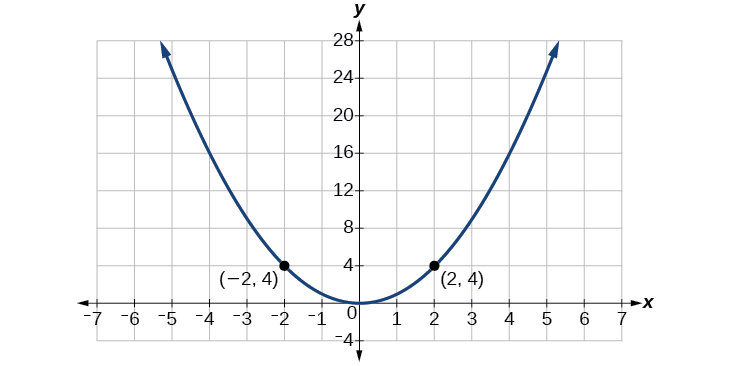
Now consider the function
shown in [link]. The graph is not symmetrical about the y-axis. All along the graph, any two points with opposite x-values also have opposite y-values. So
is an odd function, one such that two inputs that are opposites have outputs that are also opposites. That means
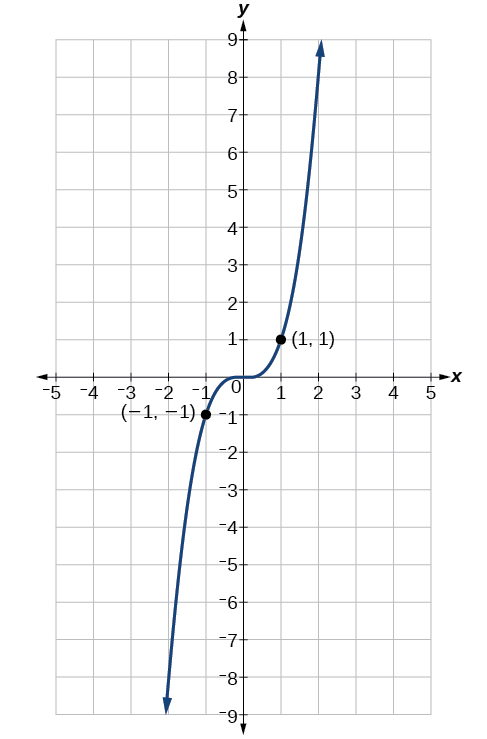
We can test whether a trigonometric function is even or odd by drawing a unit circle with a positive and a negative angle, as in [link]. The sine of the positive angle is
The sine of the negative angle is
The sine function, then, is an odd function. We can test each of the six trigonometric functions in this fashion. The results are shown in [link].
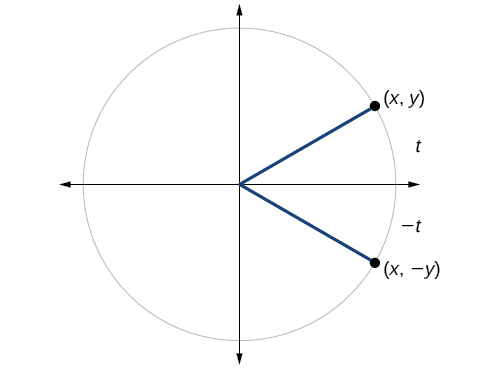
An even function is one in which
An odd function is one in which
Cosine and secant are even:
Sine, tangent, cosecant, and cotangent are odd:
If the secant of angle
is 2, what is the secant of
Secant is an even function. The secant of an angle is the same as the secant of its opposite. So if the secant of angle
is 2, the secant of
is also 2.
If the cotangent of angle
is
what is the cotangent of
We have explored a number of properties of trigonometric functions. Now, we can take the relationships a step further, and derive some fundamental identities. Identities are statements that are true for all values of the input on which they are defined. Usually, identities can be derived from definitions and relationships we already know. For example, the Pythagorean Identity we learned earlier was derived from the Pythagorean Theorem and the definitions of sine and cosine.
We can derive some useful identities from the six trigonometric functions. The other four trigonometric functions can be related back to the sine and cosine functions using these basic relationships:
evaluate
evaluate
Because we know the sine and cosine values for these angles, we can use identities to evaluate the other functions.
Evaluate
Simplify
We can simplify this by rewriting both functions in terms of sine and cosine.
By showing that
can be simplified to
we have, in fact, established a new identity.
Simplify
We can use these fundamental identities to derive alternate forms of the Pythagorean Identity,
One form is obtained by dividing both sides by
The other form is obtained by dividing both sides by
If
and
is in quadrant IV, as shown in [link], find the values of the other five trigonometric functions.
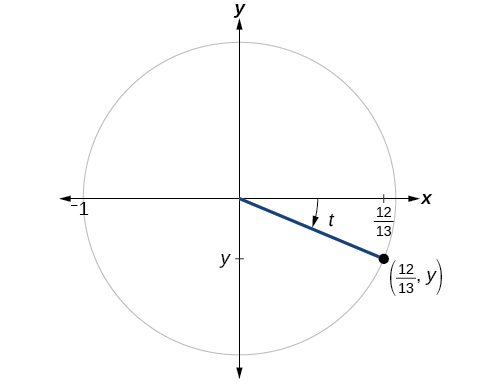
We can find the sine using the Pythagorean Identity,
and the remaining functions by relating them to sine and cosine.
The sign of the sine depends on the y-values in the quadrant where the angle is located. Since the angle is in quadrant IV, where the y-values are negative, its sine is negative,
The remaining functions can be calculated using identities relating them to sine and cosine.
If
and
find the values of the other five functions.
As we discussed at the beginning of the chapter, a function that repeats its values in regular intervals is known as a periodic function. The trigonometric functions are periodic. For the four trigonometric functions, sine, cosine, cosecant and secant, a revolution of one circle, or
will result in the same outputs for these functions. And for tangent and cotangent, only a half a revolution will result in the same outputs.
Other functions can also be periodic. For example, the lengths of months repeat every four years. If
represents the length time, measured in years, and
represents the number of days in February, then
This pattern repeats over and over through time. In other words, every four years, February is guaranteed to have the same number of days as it did 4 years earlier. The positive number 4 is the smallest positive number that satisfies this condition and is called the period. A period is the shortest interval over which a function completes one full cycle—in this example, the period is 4 and represents the time it takes for us to be certain February has the same number of days.
The period
of a repeating function
is the number representing the interval such that
for any value of
The period of the cosine, sine, secant, and cosecant functions is
The period of the tangent and cotangent functions is
Find the values of the six trigonometric functions of angle
based on [link].
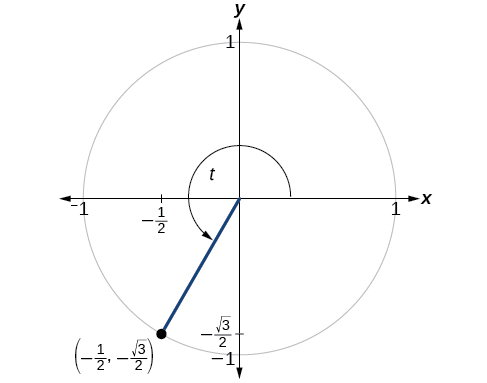
If
We have learned how to evaluate the six trigonometric functions for the common first-quadrant angles and to use them as reference angles for angles in other quadrants. To evaluate trigonometric functions of other angles, we use a scientific or graphing calculator or computer software. If the calculator has a degree mode and a radian mode, confirm the correct mode is chosen before making a calculation.
Evaluating a tangent function with a scientific calculator as opposed to a graphing calculator or computer algebra system is like evaluating a sine or cosine: Enter the value and press the TAN key. For the reciprocal functions, there may not be any dedicated keys that say CSC, SEC, or COT. In that case, the function must be evaluated as the reciprocal of a sine, cosine, or tangent.
If we need to work with degrees and our calculator or software does not have a degree mode, we can enter the degrees multiplied by the conversion factor
to convert the degrees to radians. To find the secant of
we could press
Given an angle measure in radians, use a scientific calculator to find the cosecant.
Given an angle measure in radians, use a graphing utility/calculator to find the cosecant.
Evaluate the cosecant of
For a scientific calculator, enter information as follows:
Evaluate the cotangent of
Access these online resources for additional instruction and practice with other trigonometric functions.
| Tangent function |
| Secant function |
| Cosecant function |
| Cotangent function |
and odd if
for all x in the domain of f.
of a repeating function
is the smallest interval such that
for any value of
On an interval of
can the sine and cosine values of a radian measure ever be equal? If so, where?
Yes, when the reference angle is
and the terminal side of the angle is in quadrants I and III. Thus, a
the sine and cosine values are equal.
What would you estimate the cosine of
degrees to be? Explain your reasoning.
For any angle in quadrant II, if you knew the sine of the angle, how could you determine the cosine of the angle?
Substitute the sine of the angle in for
in the Pythagorean Theorem
Solve for
and take the negative solution.
Describe the secant function.
Tangent and cotangent have a period of
What does this tell us about the output of these functions?
The outputs of tangent and cotangent will repeat every
units.
For the following exercises, find the exact value of each expression.
1
2
For the following exercises, use reference angles to evaluate the expression.
–1
-2
2
–2
–1
If
and
is in quadrant II, find
and
If
and
is in quadrant III, find
and
If
and
find
If
and
find
and
If
and
find
and
If
what is the
If
what is the
If
what is the
3.1
If
what is the
If
what is the
1.4
If
what is the
For the following exercises, use the angle in the unit circle to find the value of the each of the six trigonometric functions.
For the following exercises, use a graphing calculator to evaluate to three decimal places.
–0.228
–2.414
1.414
1.540
1.556
For the following exercises, use identities to evaluate the expression.
If
and
find
If
and
find
If
and
find
If
and
find
Determine whether the function
is even, odd, or neither.
Determine whether the function
is even, odd, or neither.
even
Determine whether the function
is even, odd, or neither.
Determine whether the function
is even, odd, or neither.
even
For the following exercises, use identities to simplify the expression.
The amount of sunlight in a certain city can be modeled by the function
where
represents the hours of sunlight, and
is the day of the year. Use the equation to find how many hours of sunlight there are on February 10, the 42nd day of the year. State the period of the function.
The amount of sunlight in a certain city can be modeled by the function
where
represents the hours of sunlight, and
is the day of the year. Use the equation to find how many hours of sunlight there are on September 24, the 267th day of the year. State the period of the function.
13.77 hours, period:
The equation
models the blood pressure,
where
represents time in seconds. (a) Find the blood pressure after 15 seconds. (b) What are the maximum and minimum blood pressures?
The height of a piston,
in inches, can be modeled by the equation
where
represents the crank angle. Find the height of the piston when the crank angle is
7.73 inches
The height of a piston,
in inches, can be modeled by the equation
where
represents the crank angle. Find the height of the piston when the crank angle is
For the following exercises, convert the angle measures to degrees.
For the following exercises, convert the angle measures to radians.
Find the length of an arc in a circle of radius 7 meters subtended by the central angle of
10.385 meters
Find the area of the sector of a circle with diameter 32 feet and an angle of
radians.
For the following exercises, find the angle between
and
that is coterminal with the given angle.
For the following exercises, find the angle between 0 and
in radians that is coterminal with the given angle.
For the following exercises, draw the angle provided in standard position on the Cartesian plane.
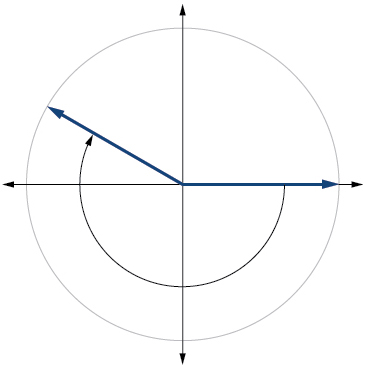
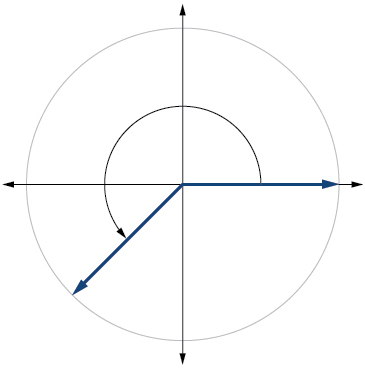
Find the linear speed of a point on the equator of the earth if the earth has a radius of 3,960 miles and the earth rotates on its axis every 24 hours. Express answer in miles per hour. Round to the nearest hundredth.
1036.73 miles per hour
A car wheel with a diameter of 18 inches spins at the rate of 10 revolutions per second. What is the car’s speed in miles per hour? Round to the nearest hundredth.
For the following exercises, use side lengths to evaluate.
For the following exercises, use the given information to find the lengths of the other two sides of the right triangle.
For the following exercises, use [link] to evaluate each trigonometric function.
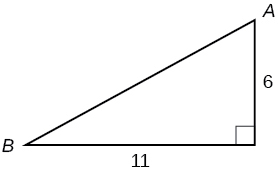
For the following exercises, solve for the unknown sides of the given triangle.
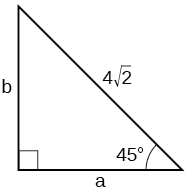
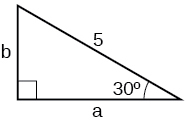
A 15-ft ladder leans against a building so that the angle between the ground and the ladder is
How high does the ladder reach up the side of the building? Find the answer to four decimal places.
The angle of elevation to the top of a building in Baltimore is found to be 4 degrees from the ground at a distance of 1 mile from the base of the building. Using this information, find the height of the building. Find the answer to four decimal places.
369.2136 ft
Find the exact value of
Find the exact value of
Find the exact value of
State the reference angle for
State the reference angle for
Compute cosine of
Compute sine of
State the domain of the sine and cosine functions.
all real numbers
State the range of the sine and cosine functions.
For the following exercises, find the exact value of the given expression.
For the following exercises, use reference angles to evaluate the given expression.
2
If
what is the
–2.5
If
what is the
If
find
If
find
Which trigonometric functions are even?
cosine, secant
Which trigonometric functions are odd?
Convert
radians to degrees.
Convert
to radians.
Find the length of a circular arc with a radius 12 centimeters subtended by the central angle of
6.283 centimeters
Find the area of the sector with radius of 8 feet and an angle of
radians.
Find the angle between
and
that is coterminal with
Find the angle between 0 and
in radians that is coterminal with
Draw the angle
in standard position on the Cartesian plane.
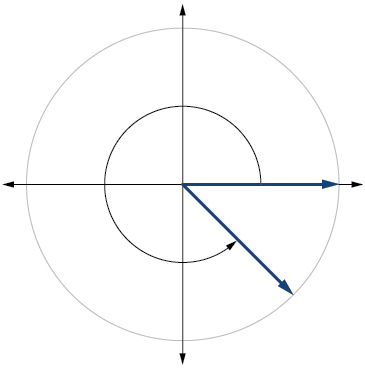
Draw the angle
in standard position on the Cartesian plane.
A carnival has a Ferris wheel with a diameter of 80 feet. The time for the Ferris wheel to make one revolution is 75 seconds. What is the linear speed in feet per second of a point on the Ferris wheel? What is the angular speed in radians per second?
3.351 feet per second,
radians per second
Find the missing sides of the triangle
Find the missing sides of the triangle.
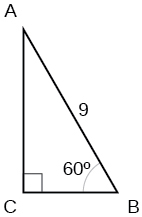
The angle of elevation to the top of a building in Chicago is found to be 9 degrees from the ground at a distance of 2000 feet from the base of the building. Using this information, find the height of the building.
Find the exact value of
Compute sine of
State the domain of the sine and cosine functions.
real numbers
State the range of the sine and cosine functions.
Find the exact value of
1
Find the exact value of
Use reference angles to evaluate
Use reference angles to evaluate
If
what is the
–0.68
If
find
Find the missing angle:
of a repeating function
such that

You can also download for free at http://cnx.org/contents/13ac107a-f15f-49d2-97e8-60ab2e3b519c@11.1
Attribution: